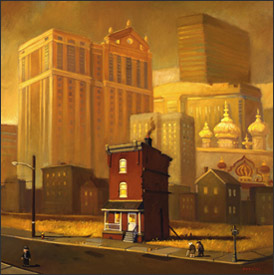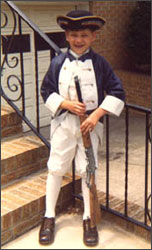 John Puglisi was born in a small town in northern New Jersey. Growing up with oil refineries and chemical plants in his backyard, he dreamed of getting out. A life on the factory assembly line was not an appealing proposition. After receiving a BFA in illustration from Pratt Institute in 1991, John's art career took him to Southern California to work in the film business. But New Jersey's smokestack skylines and John's memories of growing up in the Garden State still continue to inform his work. Train stations, bus stops, and power plants set the stage and become characters themselves in his exploration of how the constant presence of industry and enterprise shapes the human culture that springs up around it. John Puglisi was born in a small town in northern New Jersey. Growing up with oil refineries and chemical plants in his backyard, he dreamed of getting out. A life on the factory assembly line was not an appealing proposition. After receiving a BFA in illustration from Pratt Institute in 1991, John's art career took him to Southern California to work in the film business. But New Jersey's smokestack skylines and John's memories of growing up in the Garden State still continue to inform his work. Train stations, bus stops, and power plants set the stage and become characters themselves in his exploration of how the constant presence of industry and enterprise shapes the human culture that springs up around it.
In addition to producing fine art, John has worked as a conceptual illustrator and storyboard artist on animated and live-action films for DreamWorks, Disney, Universal Studios, Warner Brothers, Industrial Light and Magic, and Twentieth-Century Fox. He most recently directed an episode of NBC's "Father of the Pride" for DreamWorks Animation.
 C: What was the price of the first comic book you ever bought?
C: What was the price of the first comic book you ever bought?
P: Oh man, it was "Spider Man" in the 1970s. It must have been under a dollar. I guess it was pretty cheap. It was a long time ago.
C: Did comic books or comic strips inspire you as an artist, or to become an artist?
P: Yeah. I started to look at comics when I was about 10 or 12. It was my first real interest into seeing that art told a story. A lot of art I was looking at before that was just paintings in books. But to see a whole story play out in time - It was the first thing that I could actually follow through and see something happen over time and in sequence. And at the end of the book, it wasn't over. It was continuing. It was a story going on and it was bigger than I ever could've thought.
It was just a small piece of a much larger idea, and I thought that was interesting. It was fustrating that you had to wait a whole month for a new book to come out though.
C: When did you first start thinking that art would become a career for you?
P: Sometime in grammar school. I had a friend that was six or seven years older than me. And a friend of hers was a really good artist. Back then, in the late 70s, early 80s, the big thing in my town was that people would paint on the back of their denim jackets. They'd reproduce the (album covers). Anyway, her friend was a really good artist, and I found out that her dad was a commercial artist. And I thought, commercial artist? What does that mean?
So I met with him back in grammar school, maybe the fifth or sixth grade. He explained to me that he worked for a newspaper doing shoe ads. He would draw these renderings of shoes and things like that. And I was like, "Someone actually draws this stuff?"
I talked to him about it and I did a report on it. I did all this research and interviewed him for it. Kind of like how you're interviewing me.
I remember thinking that it seemed like a really fun way to make a living and (that thought) carried me through high school and made me pick a college that I could further my studies at.
C: Did you ever actually do comics or sequential art?
P: I had a bit of a taste of it in New York after I graduated. I worked for a company that did comics and animation, but never anything like your traditional Marvel or DC comics.
C: As a kid, did you ever draw them for fun or to show to your friends?
P: Oh yeah. I can remember when I was young, reading "Great Expectations":, and I used to illustrate the story and spell it out in sequence. I would do a drawing for each chapter or figure out a way to do each scene. I drew it like a comic, but it was all based on those classic stories.
C: Kids could look at some of your old sketchbooks and say, "Hey, I can draw better than this guy and I'm only twelve!"
 P: Yeah I know. I see kids that are so much better than I was at their age. They say, "I'll never be as good as you." And I say, "Well your better than I was when I was sixteen!" It's funny how fast and how much better kids have gotten at drawing and doing art.
P: Yeah I know. I see kids that are so much better than I was at their age. They say, "I'll never be as good as you." And I say, "Well your better than I was when I was sixteen!" It's funny how fast and how much better kids have gotten at drawing and doing art.
C: Tell me about storyboarding. It seems like storyboarding is kind of like drawing a comic book for a movie script.
P: I'm actually doing one right now. I get a script that has dialogue and I plan it out, figuring out how it fits together. It really is just an elaborate comic book. You're telling a story and figuring out the best shots and angles. If the story doesn't read on paper, it won't read when you start to shoot or edit it.
C: Do you work with the director of the film?
P: Yeah. I meet with him about once a week and we do a rough sequence, usually two or three pages, about one hundred and thirty drawings. We plan the movie out and make notes from the script. We talk before I get the assignment and he let's me know if he wants anything specific done. We figure out the choreography of the characters and how they're interacting in a room. We go back and forth and in about two or three weeks, we have a good idea, then we can move onto something else.
C: Did you ever think about turning your storyboards into a comic book?
P: It wouldn't be as dynamic, with the exception of an action sequence. But over all, it wouldn't be as dynamic as some super hero or really pumped up comic book.
C: Any words of advise for the Kids On Paper kids?
P: When I was young I spent a lot of time, alone in my room, working on my imagination. There's so much media and video games, and other stuff out there. Just sit down and spend the time to draw what you love. It's a discipline. It's like "playing the piano." Eventually, with enough practice, you can figure out all the notes and maybe then, you can "play the piano" for a living. It takes work, but being an artist is still a fun way to make a living.
|